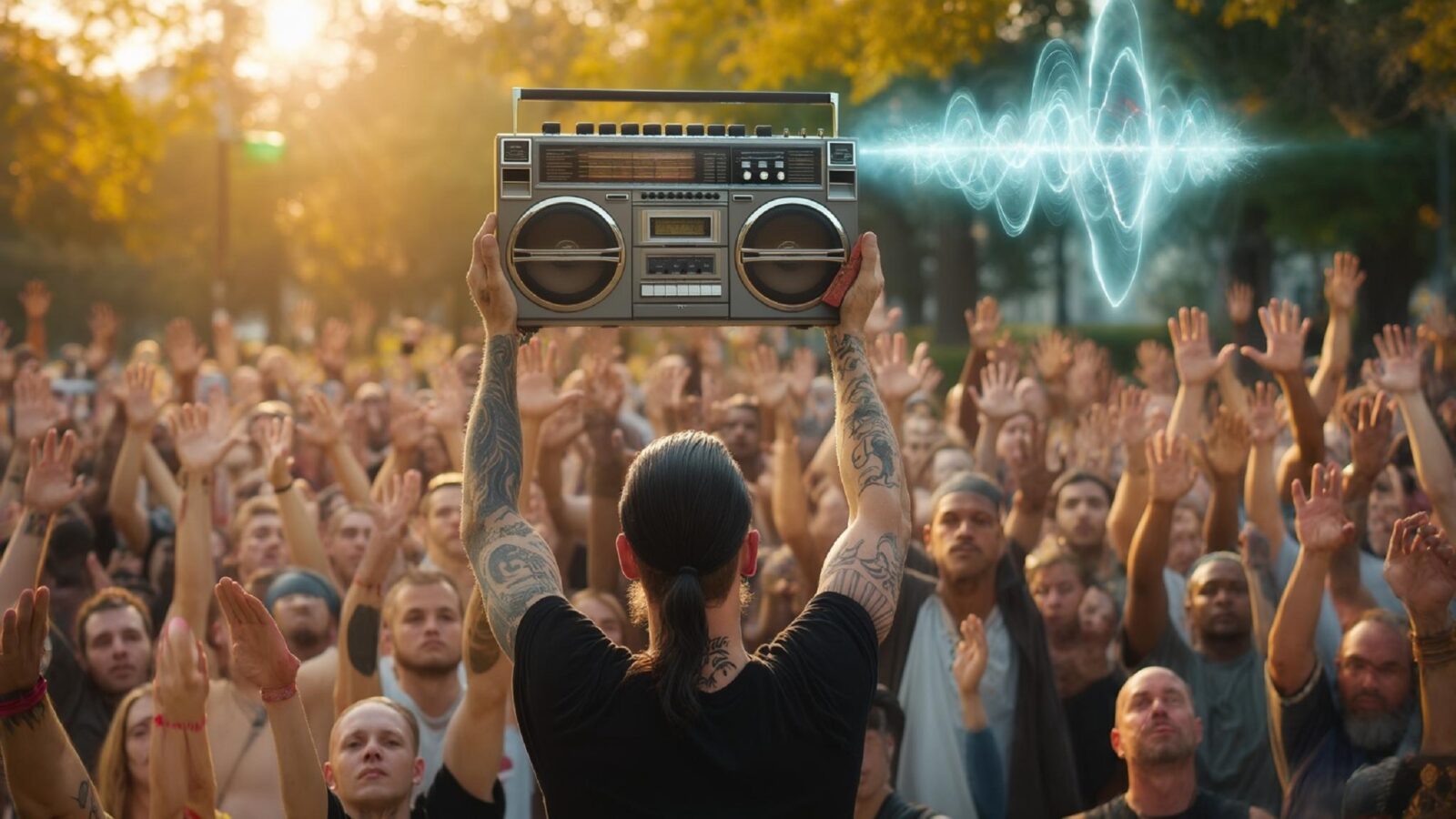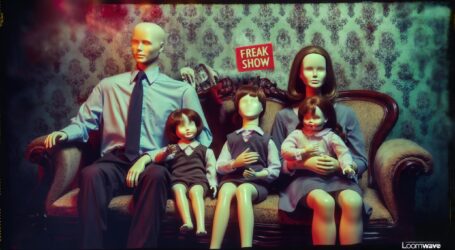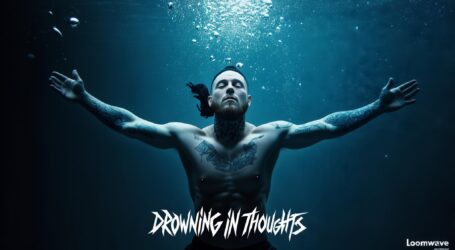Let The Music Speak by Loomwave
Sometimes the most powerful music emerges from our deepest struggles. “Let The Music Speak” represents a pivotal moment in my AI music production journey—a song born from the Industrialization era of my creative process that transforms anxiety and symptoms into raw musical expression. This track demonstrates how modern AI tools like Claude AI, Suno, and Luma Dream Machine can help artists channel personal challenges into universally resonant music.
The concept behind “Let The Music Speak” centers on a profound realization: when words fail to express our inner turmoil, music becomes our voice. Through this project, I discovered that channeling problems through music doesn’t just create art—it provides therapeutic release and helps us realize that our struggles can become our greatest creative assets.
Conceptualizing with Claude AI
The creative process began during a late-night session on March 13, 2025, when I was reflecting on my musical journey dating back to the year 2000. While researching my T-Rip discography and examining diary entries from my Industrialization era, I asked Claude AI to create a new song that would capture the essence of finding one’s voice through music.
Production Tip: When working with Claude AI for song creation, provide context from your personal experiences or specific eras of your life. The AI can draw from these authentic moments to create more emotionally resonant lyrics and concepts.
The prompt I gave Claude focused on the transformative power of music—how all my anxiety and symptoms could be channeled into musical expression, suddenly making me feel like I didn’t have problems because I could talk about them through song. This authentic emotional foundation became the cornerstone of the entire project.
The AI understood the assignment perfectly, crafting lyrics that spoke to the universal experience of using music as an emotional outlet while maintaining my personal voice and perspective from the Industrialization era.
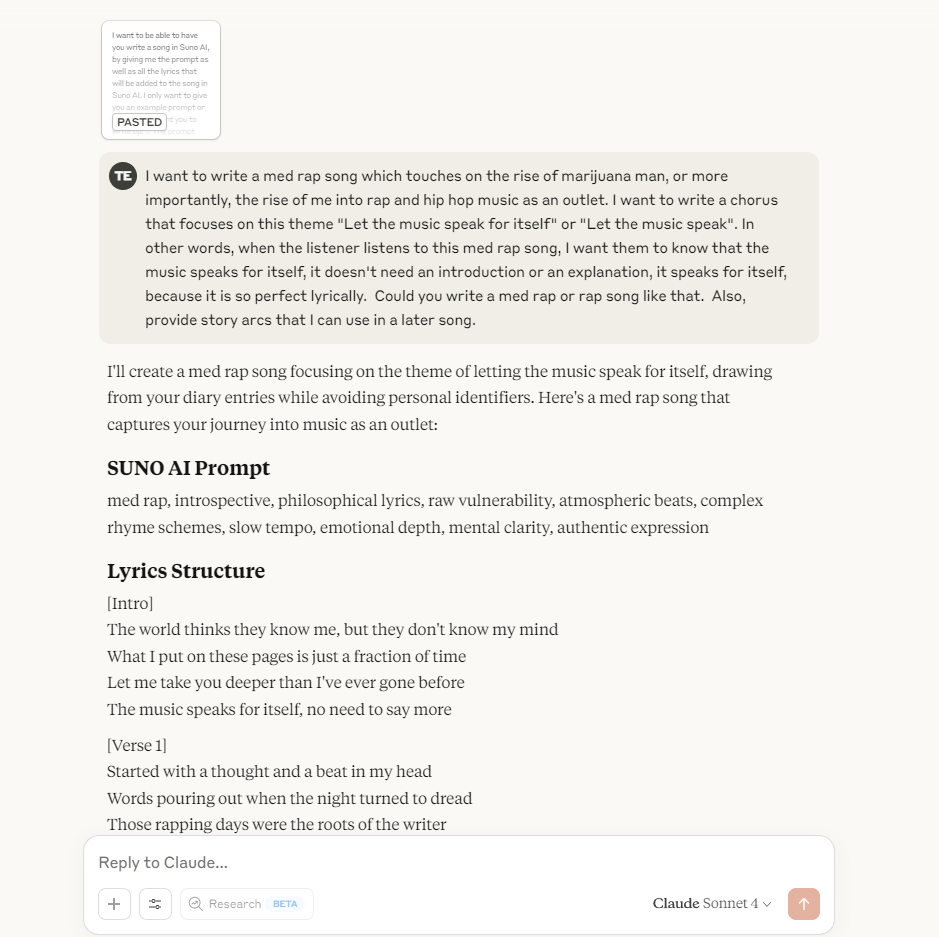
Generating Music in Suno
With the concept solidified, I moved to Suno AI for the music generation phase. This occurred during an evening session on March 13, 2025, after I had completed other daily responsibilities.
I created three different versions of “Let The Music Speak” in Suno, experimenting with various musical styles and arrangements. The beauty of working with Suno is the ability to iterate quickly—I could test different approaches to the same core concept and see which resonated most strongly.
Production Tip: Always create multiple versions of your songs in Suno. Each generation offers unique interpretations of your prompt, and you might discover unexpected musical directions that enhance your original vision.
All three versions turned out well, which validated both the strength of the concept and the effectiveness of the prompts I had developed with Claude. This success rate isn’t always guaranteed, so when you strike gold with a concept, it’s worth exploring thoroughly.
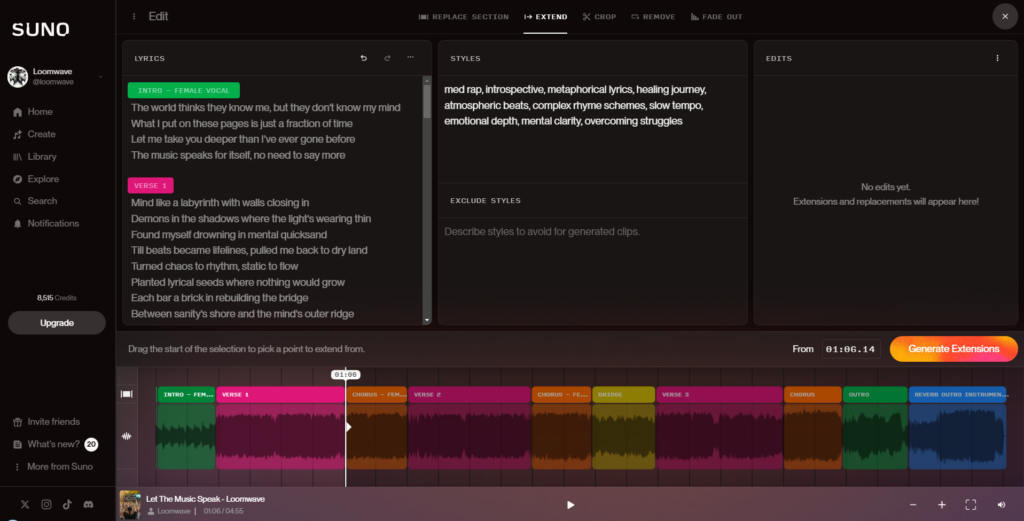
Visual Creation with Luma Dream Machine
The visual component of “Let The Music Speak” required a sophisticated approach using Luma Dream Machine. I wanted imagery that would reflect the song’s themes of finding voice through music and channeling anxiety into art.
Working with Claude AI again, I developed specific album cover prompts that Luma could interpret. The process involved creating static images first, then attempting to animate them. However, I quickly discovered an important limitation.
Production Tip: While Luma Dream Machine excels at creating compelling static images, it struggles with complex video animations involving multiple moving elements. For better video results, consider using Kling AI for animation after creating your base images in Luma.
For the final video, I created several key visual elements:
- A main character with a boom box for a head, with sparks emanating from the sides
- A crowd scene with someone holding up a boom box, with blue sound waves emanating from it
- A character with neck tattoos standing against a wall with a boom box at his feet, looking toward a skyline
- A main character with a boom box for a head, with sparks emanating from the sides
- A crowd scene with someone holding up a boom box, with blue sound waves emanating from it
- A character with neck tattoos standing against a wall with a boom box at his feet, looking toward a skyline
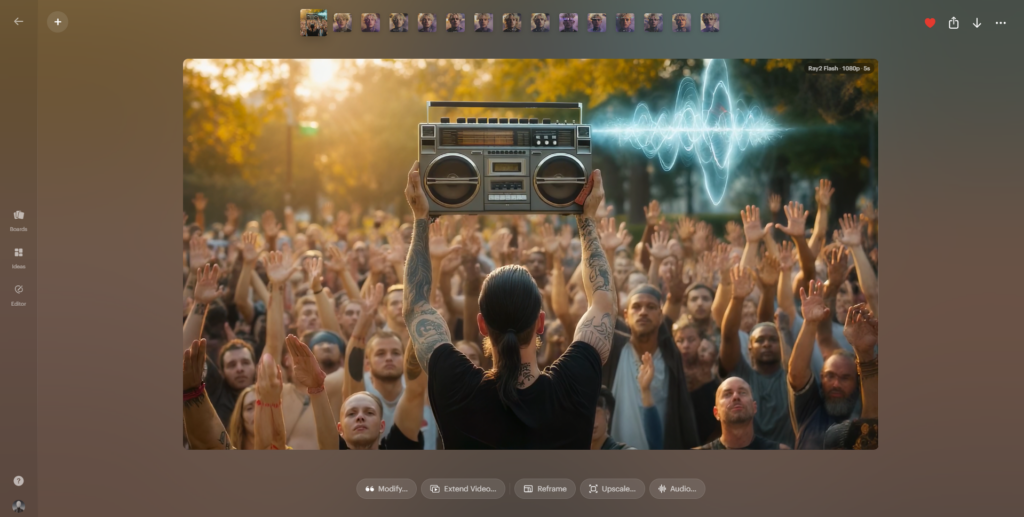
Lip Syncing Video Animation In Kling
The most technically challenging aspect of the project involved creating a lip-synced opening sequence featuring a female vocalist. This process, completed during a late-night session on March 17, 2025, required precise coordination between multiple AI tools and traditional video editing software.
I wanted to create imagery reminiscent of Amy Winehouse’s distinctive style—the beehive haircut, cat eyes, and dramatic mascara—but without creating an obvious likeness. Working with Claude AI, I developed prompts that captured these aesthetic elements while creating an original character.
Production Tip: When working with 10-second video clips that need to sync with longer audio segments, create precise time markers every 10 seconds in your audio track. This allows you to break down longer sequences into manageable chunks for AI processing.
The lip-sync process was particularly intensive:
- Breaking down the 21-second intro into two 10-second segments
- Converting video to audio in 10-second chunks
- Using Kling AI to process each segment separately with lip-sync
- Waiting approximately 10 minutes for each video to process
- Reassembling the segments in VSDC Video Editor
Production Tip: Budget significant time for lip-sync animation. A 20-second sequence required about 40 minutes of processing time, not including setup and editing. Plan accordingly for projects requiring this level of detail.
The final video featured blue neon text effects overlaying the singer, creating the impression of words appearing on glass panes in front of her—a visual metaphor for “letting the music speak.”
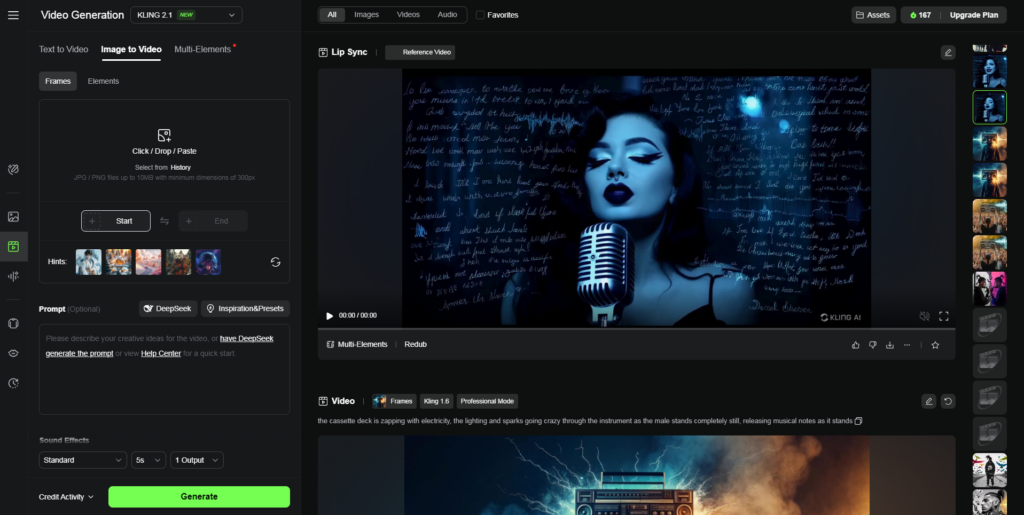
Technical Challenges and Creative Solutions
One of the biggest challenges was working within the 10-second limitation of Kling AI while needing longer sequences. The solution involved treating each 10-second segment as a separate project, then seamlessly joining them in VSDC.
Production Tip: When using Kling AI for extended sequences, ensure you have quarter-second overlaps at the beginning and end of each 10-second segment. This provides flexibility for smooth transitions during editing.
Another challenge was creating cohesive visual storytelling across different AI-generated scenes. The key was maintaining consistent themes and color palettes throughout all generated imagery, ensuring that disparate elements felt part of a unified artistic vision.
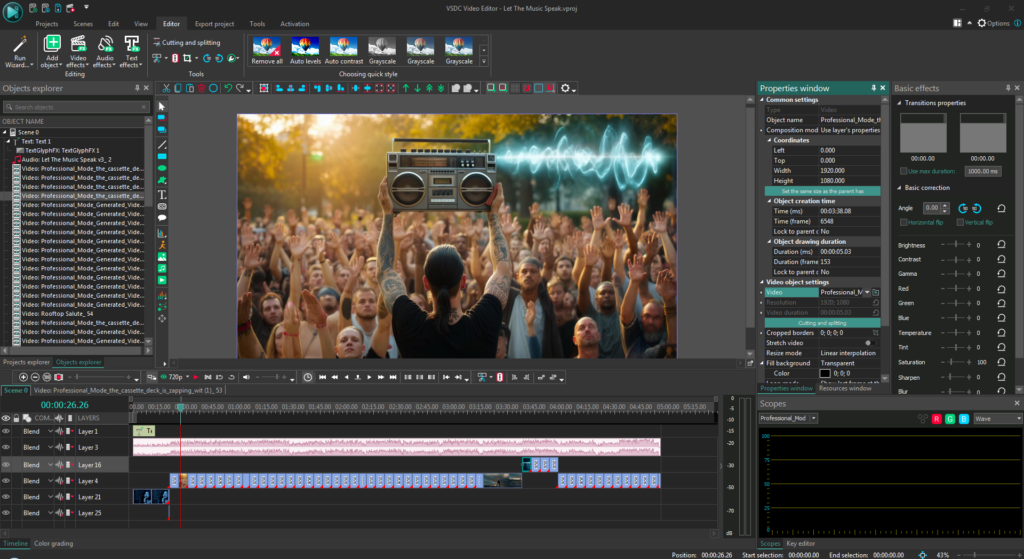
Creative Decisions and Artistic Direction
The decision to incorporate minimalistic elements alongside more complex visuals reflected the song’s core message. Sometimes the most powerful statements come from restraint—letting the music itself do the heavy lifting while visuals provide atmospheric support rather than distraction.
The choice to use multiple visual perspectives (close-up character studies, crowd scenes, urban landscapes) mirrors the multifaceted nature of finding one’s voice. We don’t express ourselves in just one way; we need multiple outlets and perspectives to fully communicate our inner experiences.
Production Tip: When creating AI music videos, vary your visual perspectives and scales. Close-ups create intimacy, crowd scenes show universality, and landscape shots provide breathing room. This variation keeps viewers engaged throughout the entire song.
Results and Lessons Learned
“Let The Music Speak” represents a breakthrough in my understanding of how AI tools can work together to create emotionally authentic content. The song successfully transforms personal struggles into universal themes while maintaining the technical polish that modern audiences expect.
The project reinforced several key insights about AI music production:
- Authentic emotional input leads to more compelling AI-generated content
- Multiple tool integration requires careful planning and patience
- Technical limitations can spark creative solutions
- Personal narrative provides the strongest foundation for AI collaboration
Production Tip: Keep detailed notes of your AI prompts and settings. Successful combinations of tools and techniques can be replicated and refined for future projects.
Future Implications for AI Music Production
This project demonstrates the maturation of AI music production tools and their ability to handle complex, multi-layered creative projects. The seamless integration of concept development (Claude AI), music generation (Suno), visual creation (Luma), and video animation (Kling) points toward a future where individual creators can produce professional-quality content independently.
The therapeutic aspect of the creative process—using music production as a means of processing personal challenges—suggests that AI tools aren’t just changing how we make music, but also how we relate to our own emotional experiences through art.
Conclusion
“Let The Music Speak” proves that the most powerful music often comes from our most vulnerable moments. By combining authentic personal experience with cutting-edge AI tools, creators can transform their struggles into art that resonates with others facing similar challenges.
The song stands as a testament to the principle that drives all of my work: technology should amplify human experience, not replace it. When we let the music speak, we discover that our voices—enhanced by AI—can reach further and touch more deeply than we ever imagined possible.
For more AI music production insights and behind-the-scenes content, explore the complete Diary of a Mad Chaos archive and discover how creativity and technology intersect in the modern musical landscape.

Diary Of A Mad Chaos is a daily diary written from March 1996 until today, of which individual books and book series have been created, namely “The Lost Years” an exploration of young, entwined love, the “Wubao In China (猎艳奇缘)” book series which provides an extensive comparative analysis of the cultural differences between Eastern and Western societies, and the book titled “Foreigner (华人)” an exploration of race relations in Australia.


